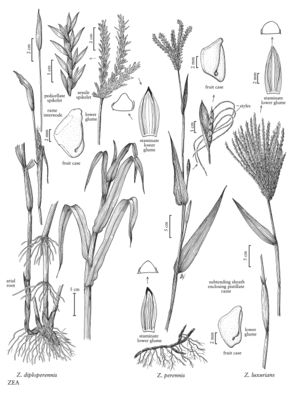Difference between revisions of "Zea diploperennis"
FNA>Volume Importer |
GeoffLevin (talk | contribs) (Fixed spelling of "Iltis" throughout) |
||
| (9 intermediate revisions by 2 users not shown) | |||
| Line 1: | Line 1: | ||
{{Treatment/ID | {{Treatment/ID | ||
|accepted_name=Zea diploperennis | |accepted_name=Zea diploperennis | ||
| − | |accepted_authority=H.H. | + | |accepted_authority=H.H. Iltis, Doebley & R. Guzman |
|publications= | |publications= | ||
|basionyms= | |basionyms= | ||
| Line 15: | Line 15: | ||
-->{{Treatment/Body | -->{{Treatment/Body | ||
| − | |discussion=<p>Zea diploperennis, although locally abundant, is rare in the wild, being known only from a few populations in the Sierra de Manantlan, Jalisco, Mexico. It grows at elevations of 1400-2400 m, sometimes forming large clones or extensive colonies in old maize fields and on the edges of oak-pine cloud forests. It is grown for genetic research and plant breeding in many countries and occasionally as an ornamental plant in warmer parts of the contiguous United States. It hybridizes infrequently with Z. mays subsp. mays in its native range.</p> | + | |discussion=<p><i>Zea diploperennis</i>, although locally abundant, is rare in the wild, being known only from a few populations in the Sierra de Manantlan, Jalisco, Mexico. It grows at elevations of 1400-2400 m, sometimes forming large clones or extensive colonies in old maize fields and on the edges of oak-pine cloud forests. It is grown for genetic research and plant breeding in many countries and occasionally as an ornamental plant in warmer parts of the contiguous United States. It hybridizes infrequently with <i>Z. mays </i>subsp.<i> mays</i> in its native range.</p> |
|tables= | |tables= | ||
|references= | |references= | ||
| Line 24: | Line 24: | ||
-->{{#Taxon: | -->{{#Taxon: | ||
name=Zea diploperennis | name=Zea diploperennis | ||
| − | + | |authority=H.H. Iltis, Doebley & R. Guzman | |
| − | |authority=H.H. | ||
|rank=species | |rank=species | ||
|parent rank=genus | |parent rank=genus | ||
| Line 31: | Line 30: | ||
|basionyms= | |basionyms= | ||
|family=Poaceae | |family=Poaceae | ||
| + | |illustrator=Linda A. Vorobik | ||
| + | |illustration copyright=Utah State University | ||
|reference=None | |reference=None | ||
|publication title= | |publication title= | ||
|publication year= | |publication year= | ||
|special status= | |special status= | ||
| − | |source xml=https:// | + | |source xml=https://bitbucket.org/aafc-mbb/fna-data-curation/src/200273ad09963decb8fc72550212de541d86569d/coarse_grained_fna_xml/V25/V25_1661.xml |
|subfamily=Poaceae subfam. Panicoideae | |subfamily=Poaceae subfam. Panicoideae | ||
|tribe=Poaceae tribe Andropogoneae | |tribe=Poaceae tribe Andropogoneae | ||
Latest revision as of 16:01, 30 November 2021
Plants perennial; rhizomatous, rhizomes to 15 cm, internodes 0.2-0.6 cm, often forming scaly, tuberous short shoots 1-2 cm thick. Culms 1-3.5 m tall, (1)2-3 cm thick, solitary or in large clumps. Blades usually to 40 cm long, 4-5.5 cm wide, linear-lanceolate. Pistillate peduncles (1)2-4(5) per node, 5-25(52) cm, the 3-5 longer peduncles extending far beyond the subtending leaf sheaths, each peduncle with 1(2) pistillate rames; pistillate rames 5-10 cm long, 4-5 mm thick, distichous, with 5-10 solitary spikelets, frequently not enclosed in a leaf sheath; fruitcases trapezoidal in side view, 6-9 mm on the long side, 2.5-4.5 mm on the short side, 4-5 mm in diameter. Caryopses concealed by the lower glumes. Terminal staminate panicles 6-18 cm, with 2-15 branches; branches 6-15 cm, erect to divergent, internodes 2-6 mm; spikelets 8.5-11.5 mm long, about 3 mm wide, densely imbricate; lower glumes flat dorsally, stiff, not translucent, margins tightly enclosing the upper glumes, the 2 principal sublateral veins prominently keeled and apically winged. 2n = 20.
Discussion
Zea diploperennis, although locally abundant, is rare in the wild, being known only from a few populations in the Sierra de Manantlan, Jalisco, Mexico. It grows at elevations of 1400-2400 m, sometimes forming large clones or extensive colonies in old maize fields and on the edges of oak-pine cloud forests. It is grown for genetic research and plant breeding in many countries and occasionally as an ornamental plant in warmer parts of the contiguous United States. It hybridizes infrequently with Z. mays subsp. mays in its native range.
Selected References
None.
